1. Skeletal System
1.1. 206 bones in the body including skull, ribs and back bone
1.1.1. Supports the body and gives it shape
1.1.2. Protect important oragns such as the lungs, the heart and the brain
2. Muscular System
2.1. Muscles in the body
2.1.1. Enables us to move different parts of the body
3. Sense Organ Systems
3.1. Eyes
3.1.1. Enable us to see
3.2. Ears
3.2.1. Enable us to hear
3.3. Nose
3.3.1. Enable us to smell
3.4. Tounge
3.4.1. Enable us to tase
3.5. Skin
3.5.1. Enable us to feel
4. Introduction
4.1. System is made up of 2 or more parts that function together
5. Plants
5.1. Roots
5.1.1. Xylem
5.1.1.1. Transports Water to stems
5.1.2. Take in water and Minerals
5.1.3. Hold plant firmly to the ground
5.2. Leaves
5.2.1. Phloem
5.2.1.1. Transport food to stem
5.2.2. Photosynthesis to make food for plant
5.3. Stem
5.3.1. Transport water and food to all parts of plant
5.3.2. Supports the branches and leaves
5.3.3. Joins the branches and leaves
5.4. Flowers
5.4.1. Reproductive structure of a plant that enables the plant to bear fruits and seeds
5.5. Fruits
5.5.1. Seed
5.5.1.1. Germinate to make new plants
5.5.2. Contains and protects seeds
5.6. Factors of water loss in plats are
6. Cells
6.1. Plant cell
6.1.1. Have nucleus, cytoplasm, cell membrane, chloroplast and cell wall
6.1.1.1. Cell wall
6.1.1.1.1. A stiff layer around the cell membrane
6.1.1.1.2. Gives the plant cell its shape
6.1.1.2. Cytoplasm
6.1.1.2.1. A jelly-like substance that contains many cell parts
6.1.1.2.2. Allow substances to move within the cell
6.1.1.3. Chloroplasts
6.1.1.3.1. A tiny disc-like cell part that contains a green pigment call chlorophyll
6.1.1.3.2. Captures sunlight for plants to make food
6.1.1.4. Cell membrane
6.1.1.4.1. Allows substances to move in and out of the cell
6.1.1.4.2. A thin layer that surrounds the cytoplasm
6.1.1.5. Nucleus
6.1.1.5.1. A round or oval cell part inside the cytoplasm
6.1.1.5.2. Contains information that is passed on from one generation to another
6.1.1.5.3. Controls everything that happens inside the cell
6.2. Animal cell
6.2.1. Have nucleus, cytoplasm and cell membrane
6.2.1.1. Cell membrane
6.2.1.1.1. Allows substances to move in and out of the cell
6.2.1.1.2. A thin layer that surrounds the cytoplasm
6.2.1.2. Cytoplasm
6.2.1.2.1. A jelly-like substance that contains many cell parts
6.2.1.2.2. Allow substances to move within the cell
6.2.1.3. Nucleus
6.2.1.3.1. A round or oval cell part inside the cytoplasm
6.2.1.3.2. Contains information that is passed on from one generation to another
6.2.1.3.3. Controls everything that happens inside the cell
7. Digestive System
7.1. Mouth
7.1.1. Saliva
7.1.1.1. To make the food wet and soft so that it can be swallowed easily
7.1.1.2. Break down some food into simpler substances as saliva contains digestive juices
7.1.1.3. The soft chewed food is then rolled into small balls and swallowed
7.1.2. Teeth
7.1.2.1. Chew food into smaller pieces as it helps to increase the surface area of food that digestive juices can act on
7.1.3. Tounge
7.1.3.1. Mixes smaller pieces of food with the saliva
7.2. Gullet/Oesophagus
7.2.1. Transport eaten food from the mouth to the stomach
7.2.2. Has muscles to push the chewed food down into the stomach
7.3. Stomach
7.3.1. Muscular and elastic bag that produces digestive juices
7.3.2. Food is mixed ith the digestive juices to break down some food into simpler substances
7.3.3. Food then moves to the small intestine
7.4. Small Instestine
7.4.1. Absorbs digested food, nutrients, minerals and water
7.4.2. Digestion completed here
7.5. Large Intestine
7.5.1. Stores undigested food till it is passed out
7.5.2. Digested food, water and mminerals are absorbed to pass through the wall of the large intestine to enter the blood stream
7.6. Rectum
7.6.1. Final part of the large intestine
7.6.2. Stores waste material just before they are passed out from the anus as faeces
7.7. Anus
7.7.1. Passes out waste materials
8. Respiratory System
8.1. Nose
8.1.1. Allows air to enter and leave the body
8.1.2. Contains hair and mucus to trap the dirt in the air
8.1.3. Air that passes through is also warmed and moistened
8.2. Windpipe and Air tube
8.2.1. Transfer the air from the nose to the left and right lungs
8.3. Lungs
8.3.1. Remove carbon dioxide from the body
8.3.2. Contains Alveoli
8.3.3. Allow exchange of gases in the Alveoli
8.4. Air sacs/Alveoli
8.4.1. Alveoli's membrane is gas exchange surface
8.4.2. Has rich supply of blood vessels
8.4.3. Absorb Oxygen
8.4.4. Oxygen passes through the wall of sacs into the blood vessels
8.4.5. Release of carbon dioxide from the blood vessels through the wall of sacs into the air sacs
8.5. Thoraric Diaphragm
8.5.1. When inhaling air, the diaphragm contracts and move foward, to allow more air to enter the lungs
8.5.2. Also does non-respiratory functions, expelling vomit, feces and urine
8.5.3. When exhaling air, the elasticity of the lungs and chest wall pushes air out of the lungs
8.6. CROWNS
8.6.1. Carbon dioxide, water vapour and other rare gases, 0.03%
8.6.2. Oxygen, 21%
8.6.3. Nitrogen, 78%
9. Circulatory System
9.1. Heart
9.1.1. Transports oxygen, digested food, nutrients, minerals and water to all parts of the body
9.1.2. A four-chambered muscular organs that pumps blood around the body
9.2. Blood vessels
9.2.1. Carries blood around the body
9.2.2. Arteries
9.2.2.1. Carry oxygen-rich blood from the heart to all parts of the body
9.2.3. Capillaries
9.2.3.1. Help blood exchange materials with the cell of the body
9.2.3.2. Oxygen, water and digested food pass from through the capillary walls, into the cells
9.2.4. Veins
9.2.4.1. Carry oxygen-poor blood from all parts of the body to the heart
9.3. Blood
9.3.1. Transports waste material such as carbon dioxide away from different parts of the body
